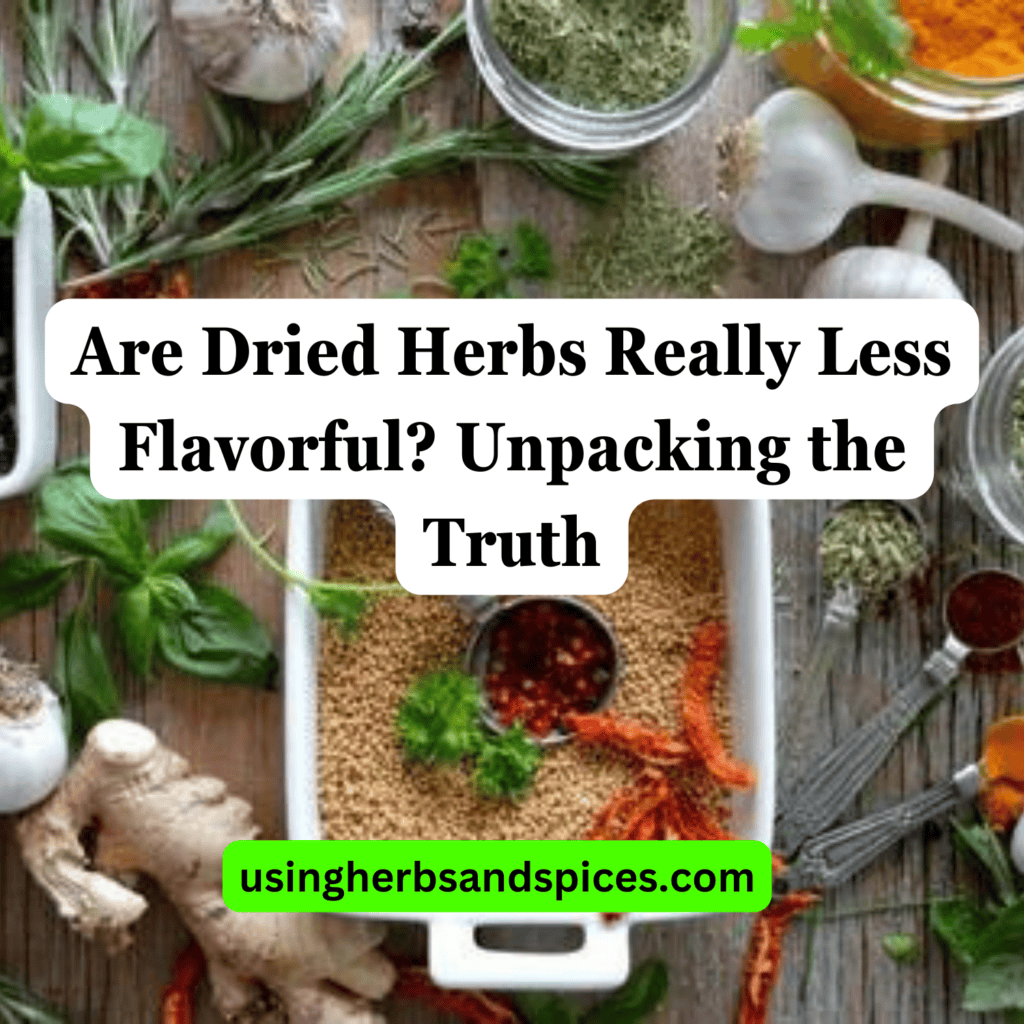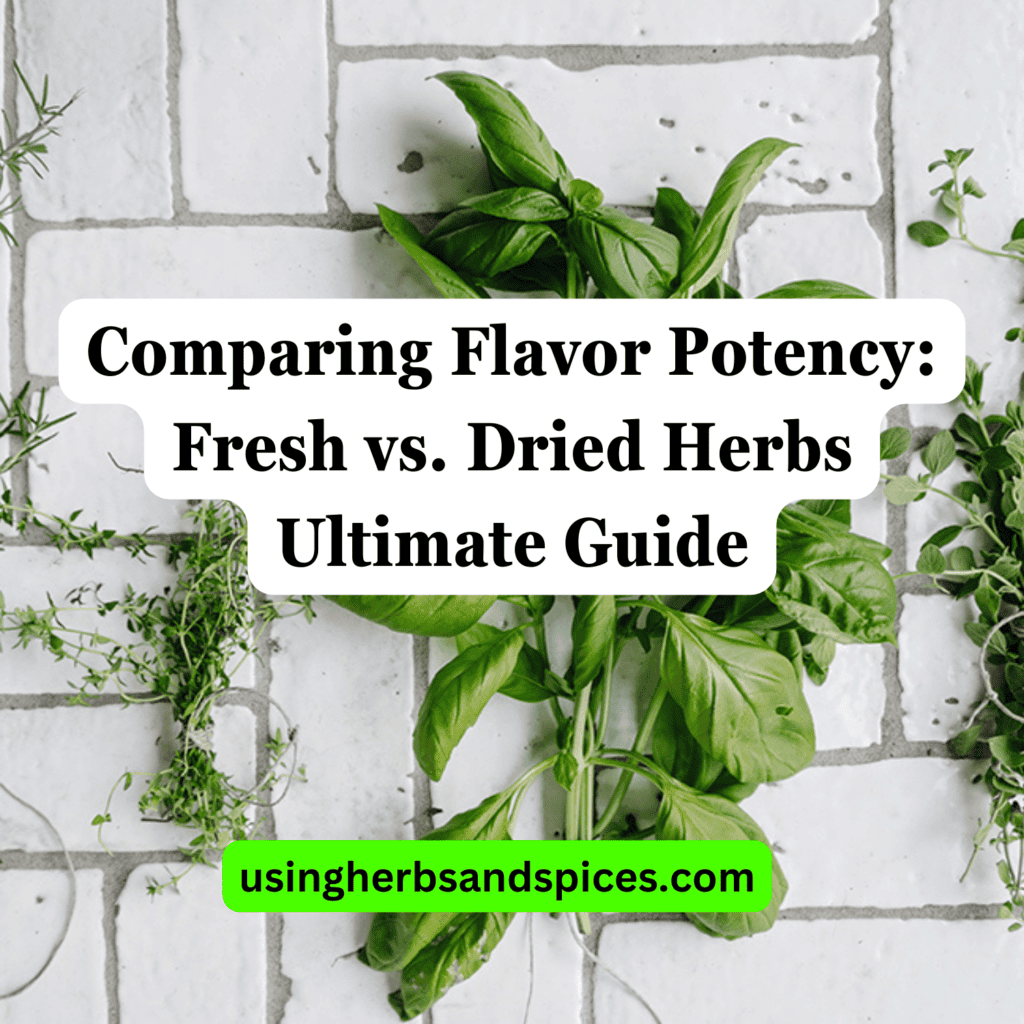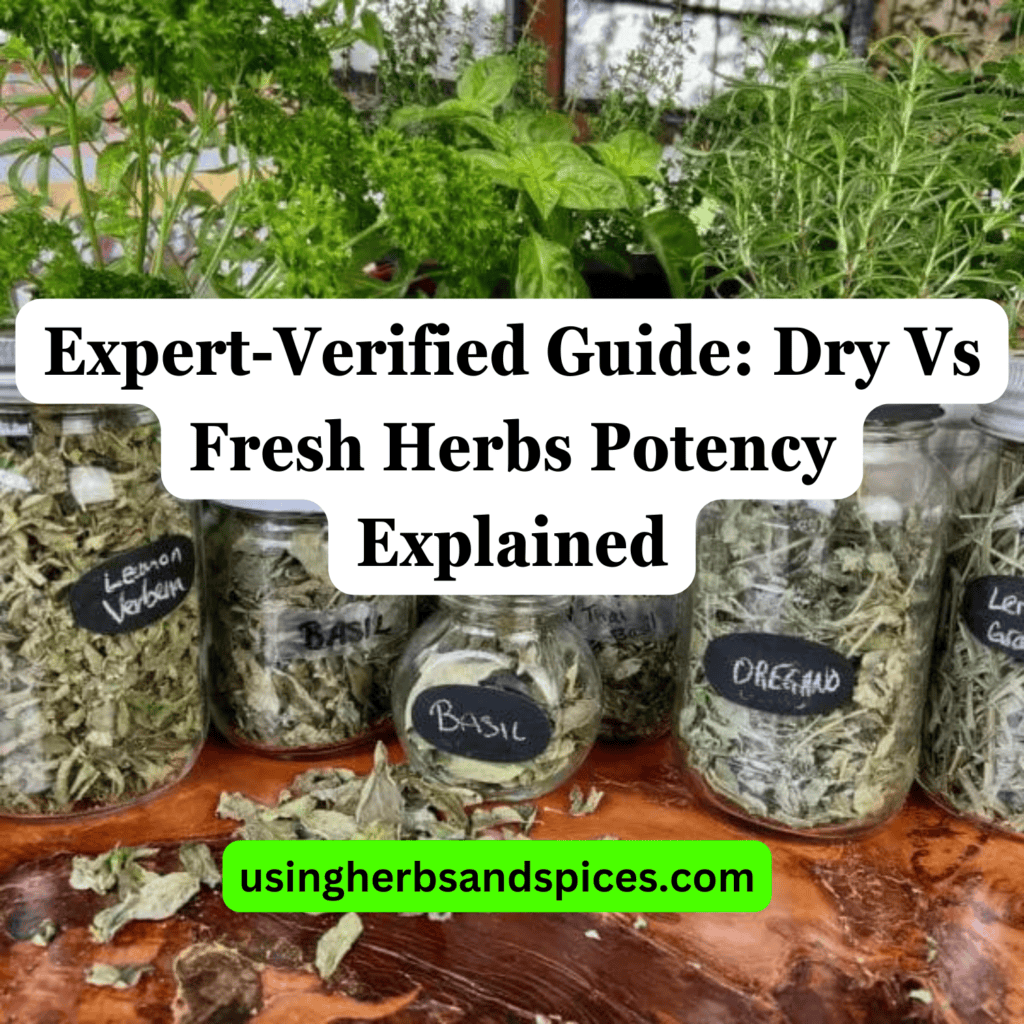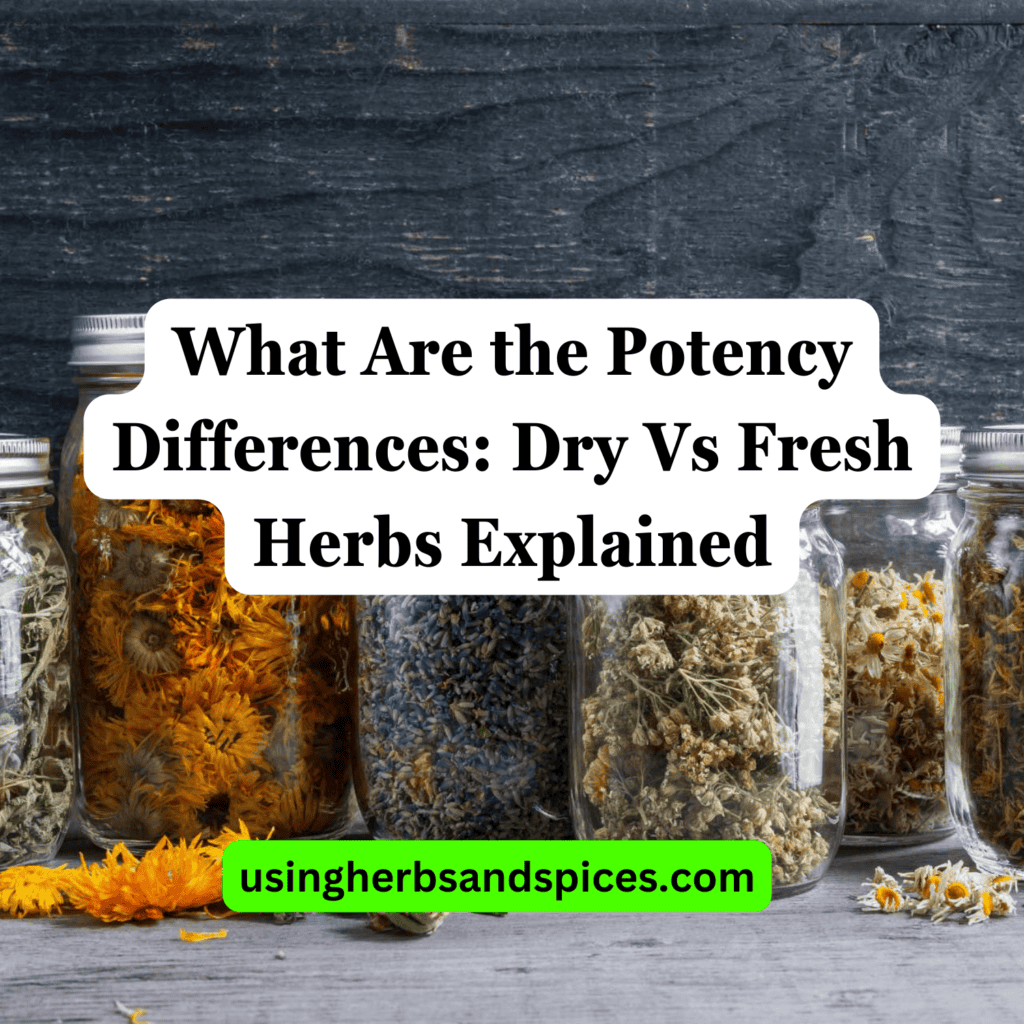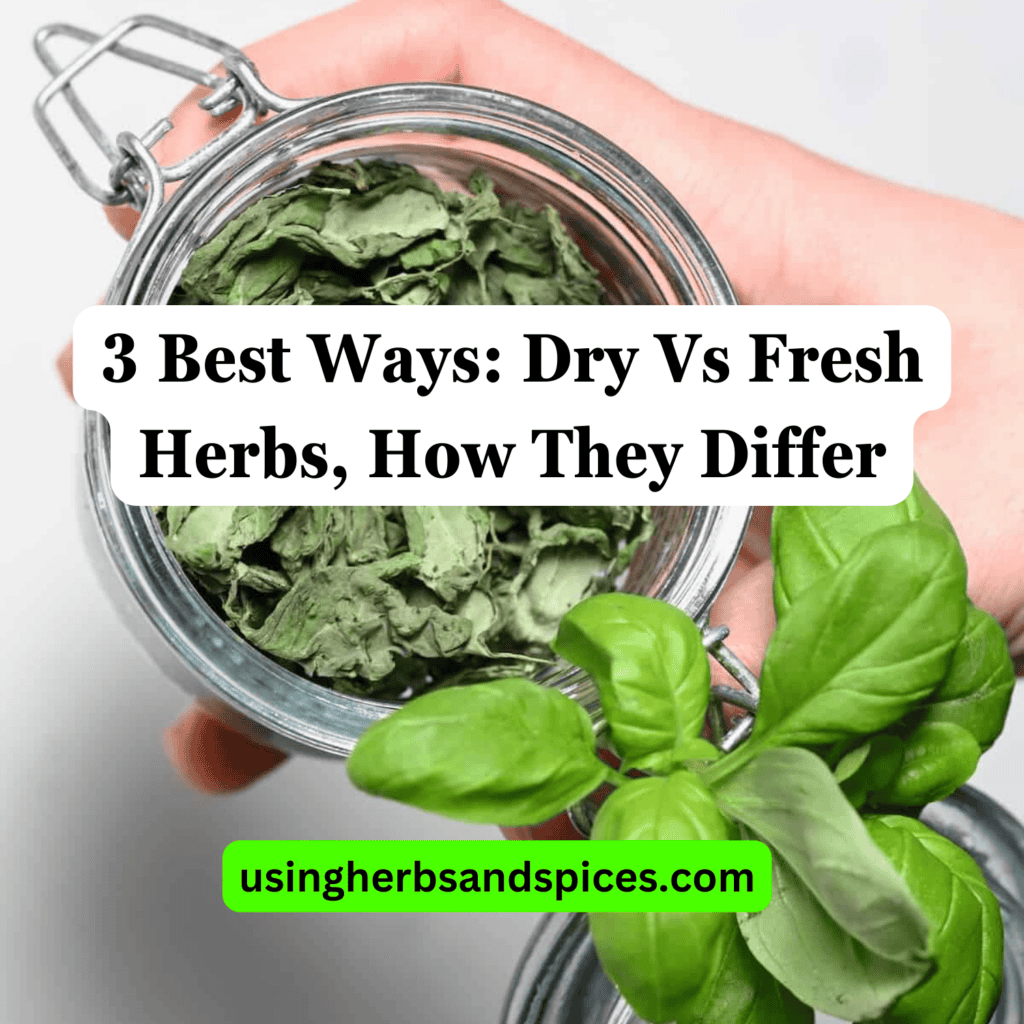SUMMARY: Dry herbs offer a concentrated flavor ideal for slow-cooked dishes, while fresh herbs provide a vibrant taste suited for finishing touches. Knowing when to use each can elevate your cooking, balancing intensity and freshness in every dish.
Ever found yourself puzzled over whether to use dried or fresh herbs in your cooking?

You’re not alone, and understanding the differences can significantly elevate your culinary game.
- The basic differences between fresh and dry herbs
- How dry herbs pack a concentrated flavor punch
- The unique vibrancy of fresh herbs
- Deciding on dry or fresh herbs for your recipes
Continue reading to master the art of using herbs and ensure your dishes are bursting with flavor.
Understanding the Basics: Fresh vs. Dry Herbs
At first glance, the choice between fresh and dry herbs might seem trivial. Yet, this decision has a profound impact on the flavor complexity and texture of your dishes. Fresh herbs often add a bright, vibrant flavor and are best added towards the end of cooking or as garnish to maintain their delicate taste and color. On the other hand, dry herbs, which are fresh herbs that have been dehydrated, offer a more concentrated flavor, making them ideal for dishes that cook longer, as they release their flavors over time.
Moreover, the process of drying changes the flavor profile of herbs. For instance, dried oregano has a more intense and less sweet flavor compared to its fresh counterpart. This intensity means that when substituting dry for fresh, the ratio typically starts at one part dry to three parts fresh. The key to maximizing the potential of each type lies in understanding these fundamental characteristics and knowing when and how to use them in your culinary creations.
The Flavor Strength of Dry Herbs
The intensification of flavor found in dry herbs is a result of the dehydration process, which concentrates their essential oils. These condensed flavors mean a small amount of dried herb can carry the punch of a significantly larger volume of its fresh counterpart. This potency makes dry herbs particularly suited for dishes that cook for longer periods, such as stews and braises, where their flavors have time to meld and infuse throughout.
When substituting dry herbs for fresh, the general rule of thumb is to use one-third of the amount specified for fresh. However, this can vary based on the herb in question and the dish’s complexity. Subtlety is key; it’s easier to add more than to correct an overpowering presence.
Understanding the strength of each dried herb is crucial for their effective use. For instance, dried bay leaves, oregano, and thyme provide a depth of flavor unachievable with their fresh counterparts but must be used judiciously to avoid overwhelming a dish. Additionally, care should be taken to ensure that dried herbs are still within their shelf life, as outdated herbs can lead to flat, uninspired dishes.
A knack for knowing when and how to use dried herbs can significantly elevate your cooking, providing warmth and complexity to your dishes. Mastering their use is an essential skill for any aspiring chef or home cook looking to deepen their culinary expertise.
The Vibrant Taste of Fresh Herbs
The aroma and flavor of fresh herbs are unmistakable, bringing a vibrant and often delicate complexity to dishes. Unlike their dried counterparts, green herbs typically possess a milder, more nuanced taste profile, which can range from the peppery freshness of basil to the citrusy undertones of fresh coriander. Their essential oils are more volatile and less concentrated, which prescribes their use in a different manner in the culinary world.
Fresh herbs are often added towards the end of the cooking process or used as a garnish to preserve their flavor and color. This method maximizes their impact, allowing the fresh, aromatic qualities to shine through without being diminished by prolonged heat, which can lead to a loss of their delicate flavor notes.
Storing fresh herbs requires a bit more care to maintain their aroma and longevity. Generally, it is best to keep them in the refrigerator, either loosely wrapped in a damp paper towel and placed in a bag or standing upright in a glass of water, similar to a bouquet of flowers. Each herb may have its specific storage needs, but by keeping them cool and hydrated, their vibrant flavors are preserved for longer duration.
Comparative Analysis: When to Use Dry or Fresh Herbs
The decision to use dry or fresh herbs can significantly affect the flavor outcome of a dish. Understanding when and how to use each type is crucial for any culinary enthusiast. Dry herbs, given their concentrated flavor, are well-suited for dishes that cook for longer periods. They withstand simmering well, releasing their flavors over time, making them ideal for soups, stews, and sauces.
On the other hand, fresh herbs are best when their bright, aromatic qualities are desired in a dish. They excel in fresh preparations such as salads, as garnishes, or added at the end of cooking to preserve their delicate flavor and vibrant color. However, there are exceptions to these rules based on the specific characteristics of the herb in question and the desired flavor profile of the dish.
A simple guideline is the ‘replacement ratio’ often cited in culinary resources: 1 tablespoon of fresh herb equals approximately 1 teaspoon of dried herb. Yet, this can vary based on the potency of the herb and personal taste preferences. Experts recommend starting with this ratio and adjusting according to taste.
Ultimately, the choice between dry and fresh herbs comes down to the desired intensity of flavor, the cooking method being employed, and the specific characteristics of the herb itself. While some herbs, like cilantro or basil, are often preferred fresh due to their distinct flavors, others like oregano, thyme, and rosemary lend themselves well to drying, which concentrates their flavors and makes them more versatile in cooking.
Elevating Culinary Creations with Fresh and Dried Herbs
In the journey through the nuanced world of herbs, we’ve unpacked the critical distinctions between using dry versus green herbs to elevate culinary creations.
- Dry herbs offer a concentrated flavor, making them suitable for slow-cooked dishes and robust flavoring.
- Fresh herbs provide a vibrant, fresh taste ideal for finishing dishes, salads, and delicate flavoring.
- Understanding the flavor strength and best culinary use of both dry and fresh herbs is key to enhancing any recipe.
- Effective substitution requires recognizing the potent flavor of dry herbs compared to their fresh counterparts.
- The choice between dry and fresh herbs should consider the cooking method, dish type, and desired intensity of flavor.
In conclusion, the art of selecting between dry and fresh herbs lies in understanding their distinct flavor profiles and how they complement different dishes. By mastering this, home cooks and chefs alike can harness the full potential of herbs to transform simple ingredients into exquisite meals.
Herbs: Comparing Flavor Strengths of Dry Vs Green FAQs
Can you substitute dry herbs for fresh herbs in cooking?
Yes, dry herbs can be substituted for fresh herbs in cooking, but it is crucial to adjust the quantity due to differences in flavor strength. Typically, because dry herbs are more concentrated, you would use one-third the amount of dry herbs to substitute for fresh herbs. This ratio can vary depending on the specific herb and its potency.
Why are dry herbs more potent than fresh?
Dry herbs are more potent than fresh because the drying process concentrates their flavors and essential oils. As herbs dry, they lose moisture, which intensifies their flavor, making them stronger and more aromatic compared to their fresh counterparts. This is why they are used more sparingly in recipes.
How should I store fresh and dry herbs to preserve their flavor?
Fresh herbs should be stored in the refrigerator, either wrapped in a damp paper towel or with their stems immersed in water, to keep them hydrated and maintain their freshness. Dry herbs, on the other hand, should be stored in airtight containers in a cool, dark place to protect their aromatic oils and prevent flavor loss over time.
When is it best to use fresh herbs over dry herbs in recipes?
It’s best to use fresh herbs in recipes that benefit from a burst of fresh flavor, such as salads, salsas, and dishes that are not cooked for long periods. Fresh herbs are also better for garnishing, providing not only flavor but visual appeal. Dry herbs are ideal for dishes that cook for longer periods, like stews and roasts, where their concentrated flavor can infuse throughout the dish.


